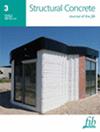水泥和非水泥混合钢纤维增强混凝土力学性能、协同作用评估和微观结构的实验研究
IF 3
3区 工程技术
Q2 CONSTRUCTION & BUILDING TECHNOLOGY
引用次数: 0
摘要
本文研究了用硅灰(SF)和偏高岭土(MK)替代普通硅酸盐水泥(OPC)对钢纤维增强混凝土(SFRC)机械性能和韧性的影响。首先,在水胶比为 0.4 的参考混凝土拌合物中掺入不同体积分数的不同几何形状的钢纤维:卷曲钢纤维 (CS) 和直钢纤维 (SS),既可单独使用,也可混合使用,以检验其力学性能。在随后的阶段,研究将宏观钢纤维和微观钢纤维结合在一起对弯曲韧性的影响,以确定合适组合的潜在协同作用。此外,研究还评估了混合钢纤维增强混凝土(Hy-SFRC)的抗弯韧度变化中可能存在的胶凝剂影响。结果发现,钢纤维杂化可有效改善混凝土拌合物的工作性,最高可达 11%。与不含胶结剂的 SFRC 相比,含胶结剂的 SFRC 混合物在抗压强度、断裂模量和弹性模量方面都有显著提高。CS 1.5% 和 SS 0.5% 的混合组合被认为是力学性能最佳的组合。此外,协同作用评估结果表明,在含毛细管的混凝土拌合物中混合钢纤维在开裂后阶段特别有效,正效应为 14%,而在开裂前阶段则为负 8%。添加水青石后,Hy-SFRC 的弯曲韧性提高了约 10%-20%。与含有二元 SF 和 MK 的 Hy-SFRC 混合物相比,在 Hy-SFRC 中混合 SF 和 MK 能有效增强混凝土的韧性机制,这表明纤维与基体之间的粘结力更强,这是由于孔隙细化和水化产物在界面上形成的结果。含有 10% SF 和 10% MK 的三元水合混合料的 Hy-SFRC 在弯曲韧性方面效果最好,相应的协同值也最大。结果与形态分析一致,形态分析表明,由于 SF 和 MK 的三元混合,骨料与混凝土基体之间以及钢纤维与混凝土基体之间的界面水化产物有所增加。本文章由计算机程序翻译,如有差异,请以英文原文为准。
Experimental investigations on mechanical performance, synergy assessment, and microstructure of pozzolanic and non‐pozzolanic hybrid steel fiber reinforced concrete
This paper investigates the effects of pozzolanic substitutions for ordinary Portland cement (OPC) with silica fume (SF) and metakaolin (MK) on the mechanical and toughness performances of steel fiber reinforced concrete (SFRC). Initially, a reference concrete mix with a water‐to‐binder ratio of 0.4 is blended with different volume fractions of steel fibers with varying geometry: crimped steel (CS) and straight steel (SS), both individually and in combination, to examine their mechanical properties. In the subsequent phase, the study investigates the impact of combining macro‐ and microsteel fibers on flexural toughness, to determine potential synergy for suitable combinations. Also, the possible influence of pozzolans in the variation of flexural toughness of hybrid steel fiber reinforced concrete (Hy‐SFRC) was evaluated. Hybridization of steel fibers was found effective in improving the workability of the concrete mix up to 11%. SFRC mixes containing pozzolans exhibited a significant enhancement in compressive strength, modulus of rupture, and modulus of elasticity compared to non‐pozzolanic SFRC. The hybrid combination of CS 1.5% and SS 0.5% was considered the best in terms of mechanical properties. Additionally, the results of synergy assessment showed that hybridization of steel fibers in the pozzolanic concrete mix was particularly effective in the post‐cracking stages with a positive 14% compared to a negative 8% in the pre‐cracking stage. The pozzolanic addition improved the flexural toughness of Hy‐SFRC to about 10%–20%. Blending of SF and MK in Hy‐SFRC was found effective in enhancing the toughness mechanism of concrete compared to Hy‐SFRC mixes containing binary SF and MK, indicating a stronger bond between the fibers and the matrix resulting from the pore refinement and hydration products developed at the interface. Hy‐SFRC containing a ternary pozzolanic mix of SF 10% and MK 10% gave the best results in flexural toughness, and the corresponding synergy values were found to be the maximum. The results were consistent with the morphology analysis, which revealed an increase in hydration products at the interface between the aggregate and concrete matrix, as well as between the steel fiber and concrete matrix, due to the ternary blending of SF and MK.
求助全文
通过发布文献求助,成功后即可免费获取论文全文。
去求助
来源期刊

Structural Concrete
CONSTRUCTION & BUILDING TECHNOLOGY-ENGINEERING, CIVIL
CiteScore
5.60
自引率
15.60%
发文量
284
审稿时长
3 months
期刊介绍:
Structural Concrete, the official journal of the fib, provides conceptual and procedural guidance in the field of concrete construction, and features peer-reviewed papers, keynote research and industry news covering all aspects of the design, construction, performance in service and demolition of concrete structures.
Main topics:
design, construction, performance in service, conservation (assessment, maintenance, strengthening) and demolition of concrete structures
research about the behaviour of concrete structures
development of design methods
fib Model Code
sustainability of concrete structures.
 求助内容:
求助内容: 应助结果提醒方式:
应助结果提醒方式:


